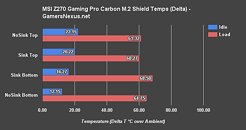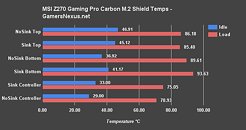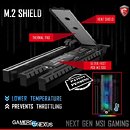- Joined
- Oct 9, 2007
- Messages
- 47,670 (7.43/day)
- Location
- Dublin, Ireland
| System Name | RBMK-1000 |
|---|---|
| Processor | AMD Ryzen 7 5700G |
| Motherboard | Gigabyte B550 AORUS Elite V2 |
| Cooling | DeepCool Gammax L240 V2 |
| Memory | 2x 16GB DDR4-3200 |
| Video Card(s) | Galax RTX 4070 Ti EX |
| Storage | Samsung 990 1TB |
| Display(s) | BenQ 1440p 60 Hz 27-inch |
| Case | Corsair Carbide 100R |
| Audio Device(s) | ASUS SupremeFX S1220A |
| Power Supply | Cooler Master MWE Gold 650W |
| Mouse | ASUS ROG Strix Impact |
| Keyboard | Gamdias Hermes E2 |
| Software | Windows 11 Pro |
With its 200-series chipset motherboards, MSI introduced its exclusive M.2 Shield accessory on some of its more premium products. This aluminium heatspreader with a thermal pad, according to its makers, is designed to lower temperatures on M.2 SSDs, and reduce thermal throttling of performance. Tests by Gamers Nexus claim that far from reducing throttling, the M.2 Shield creates a "heat trap" that throttles performance further.
The M.2 Shield accessory was tested by Gamers Nexus using a Kingston HyperX Predator PCIe M.2 drive, on an MSI Z270 Gaming Pro Carbon motherboard. Driven by a Marvell 88SS9293 controller, the drive is known to heat up and lose performance to overheating. The data presented by the publication is Delta T (temperatures subtracting ambient temperature). MSI on its part, stands by the efficacy of the M.2 Shield accessory, and is sharing testing methods and data of its own with media sites. Tests by other publications such as Bit-Tech and KitGuru show positive results for the M.2 Shield.



View at TechPowerUp Main Site
The M.2 Shield accessory was tested by Gamers Nexus using a Kingston HyperX Predator PCIe M.2 drive, on an MSI Z270 Gaming Pro Carbon motherboard. Driven by a Marvell 88SS9293 controller, the drive is known to heat up and lose performance to overheating. The data presented by the publication is Delta T (temperatures subtracting ambient temperature). MSI on its part, stands by the efficacy of the M.2 Shield accessory, and is sharing testing methods and data of its own with media sites. Tests by other publications such as Bit-Tech and KitGuru show positive results for the M.2 Shield.



View at TechPowerUp Main Site





